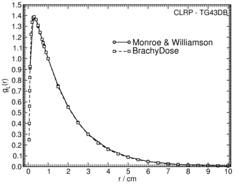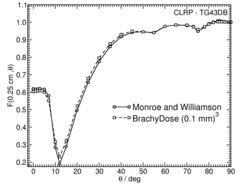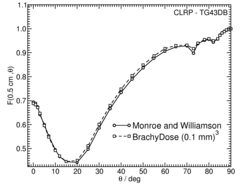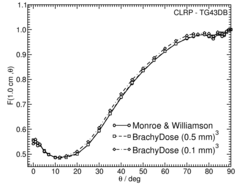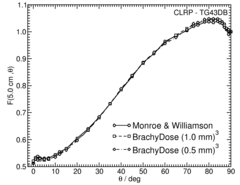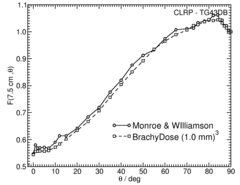

Source Description:
Dimensions for the TheraSeed 1,2,3,4 are as reported by Monroe and Williamson. The TheraSeed consists of two cylindrical graphite pellets coated with radioactive palladium and separated by a cylindrical lead marker. The graphite cylinders have a diameter of 0.560 mm and length of 0.890 mm. The lead marker is 1.09 mm long and 0.500 mm in diameter. The thickness of Pd on the graphite is 2.20 ĂÄžm. Encapsulation for the TheraSeed is a thin titanium tube that has an outer diameter of 0.826 mm with wall thickness of 0.0560 mm. The ends are sealed with two titanium end cups that are 0.040 mm thick. The end cups are composed of a 0.334 mm long hollow cylindrical section attached to a hemi-spherical shell. Both the cylindrical section and hemi-spherical shell have inner diameters of 0.306 mm. The overall source length is 4.500 mm and the active length is 4.23 mm calculated using the TG-43 effective line source length approximation. The maximum displacement of one of the cylindrical sources is 0.200 mm along the seed axis and 0.075 mm in the radial direction.
Dose Rate Constant - Λ :
Dose rate constants, Λ , are calculated by dividing the dose to water per history in a (0.1 mm) 3 voxel centered on the reference position, (1 cm,Π/2), in the 30x30x30 cm 3 water phantom, by the air kerma strength per history (scored in vacuo ). As described in ref. 4 , dose rate constants are provided for air kerma strenth calculated using voxels of 2.7x2.7x0.05 cm 3 (WAFAC) and 0.1x0.1x0.05 cm 3 (point) located 10 cm from the source. The larger voxel size averages the air kerma per history over a region covering roughly the same solid angle subtended by the primary collimator of the WAFAC 5,6 at NIST used for calibrating low-energy brachytherapy sources and is likely the most clinically relevant value. The small voxel serves to estimate the air kerma per history at a point on the transverse axis.
| Author | Method | Λ (cGy h-1 U-1) | Abs. Uncertainty |
| R. E. P. Taylor et al 4 | WAFAC | 0.694 | 0.002 |
| R. E. P. Taylor et al 4 | point | 0.772 | 0.003 |
| J. I. Monroe, J. F. Williamson 2 | extrap (PTRAN) | 0.797 | 0.02 |
| J. I. Monroe, J. F. Williamson 2 | WAFAC (PTRAN) | 0.691 | 0.02 |
| R. Nath et al 7 | TLD | 0.680 | 0.05 |
| M. J. Rivard et al 8 | Consensus Value | 0.686 |
Radial dose function - g(r):
The radial dose function, g(r), is calculated using both line and point source geometry functions and tabulated at 36 different radial distances ranging from 0.05 cm to 10 cm. Fit parameters for a modified polynomial expression are also provided 9 .
| Fitting coefficients for g L (r) = (a 0 r -2 + a 1 r -1 +a 2 + a 3 r +a 4 r 2 + a 5 r 3 ) e -a 6 r | ||||||||
| Fit range | Coefficients | |||||||
| r min (cm) | r max (cm) | a 0 / cm 2 | a 1 / cm | a 2 | a 3 / cm -1 | a 4 / cm -2 | a 5 / cm -3 | a 6 / cm -1 |
| 0.10 | 10.00 | -3.6394E-03 | -5.8095E-02 | 1.9098E+00 | -2.6445E-01 | 1.2862E-02 | 7.0066E-11 | 4.6780E-01 |
Anisotropy function - F(r,θ):
Anisotropy functions are calculated using the line source approximation and tabulated at radii of 0.1, 0.15, 0.25, 0.5, 0.75, 1, 2, 3, 4, 5, 7.5 and 10 cm and 32 unique polar angles with a minimum resolution of 5° . The anisotropy factor, φan (r), was calculated by integrating the solid angle weighted dose rate over 0° ≤ ϑ ≤ 90° .
References:
1. Z. Chen, R. Nath, Dose rate constant and energy spectrum of interstitial brachytherapy sources, Med. Phys., 28 , 86 -- 96, 2001
2. J. I. Monroe, J. F. Williamson, Monte Carlo-aided dosimetry of the Theragenics TheraSeed Model 200 103 Pd interstitial brachytherapy seed, Med. Phys., 29 , 609 -- 621, 2002
3 error: unknown reference. Correct info file or add to references.dat
4. R. E. P. Taylor et al , Benchmarking BrachyDose: voxel-based EGSnrc Monte Carlo calculations of TG--43 dosimetry parameters, Med. Phys., 34 , 445 -- 457, 2007
5. R. Loevinger, Wide-angle free-air chamber for calibration of low--energy brachytherapy sources, Med. Phys., 20 , 907, 1993
6. S. M Seltzer et al , New National Air-Kerma-Strength Standards for 125 I and 103 Pd Brachytherapy Seeds, J. Res. Natl. Inst. Stand. Technol., 108 , 337 -- 358, 2003
7. R. Nath et al , , Med. Phys., 27 , 655 -- 658} , 2000
8. M. J. Rivard et al , Update of AAPM Task Group No. 43 Report: A revised AAPM protocol for brachytherapy dose calculations, Med. Phys., 31 , 633 -- 674, 2004
9. R. E. P. Taylor, D. W. O. Rogers, More accurate fitting of 125 I and 103 Pd radial dose functions, Med. Phys., 35 , 4242--4250, 2008
Carleton Laboratory for Radiotherapy Physics
December 17 2007.
